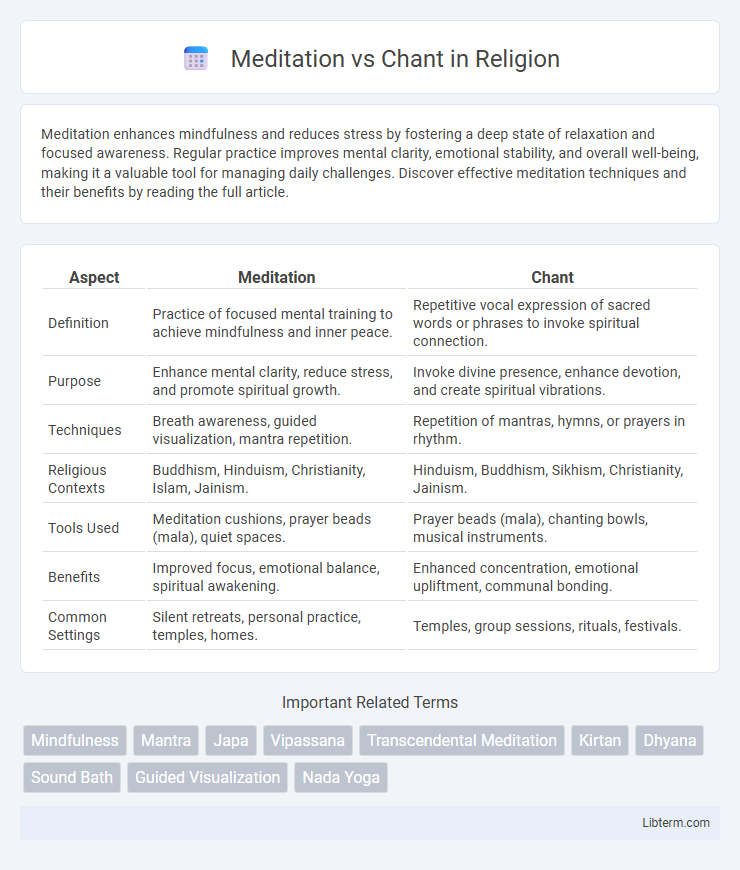Meditation enhances mindfulness and reduces stress by fostering a deep state of relaxation and focused awareness. Regular practice improves mental clarity, emotional stability, and overall well-being, making it a valuable tool for managing daily challenges. Discover effective meditation techniques and their benefits by reading the full article.
Table of Comparison
| Aspect | Meditation | Chant |
|---|---|---|
| Definition | Practice of focused mental training to achieve mindfulness and inner peace. | Repetitive vocal expression of sacred words or phrases to invoke spiritual connection. |
| Purpose | Enhance mental clarity, reduce stress, and promote spiritual growth. | Invoke divine presence, enhance devotion, and create spiritual vibrations. |
| Techniques | Breath awareness, guided visualization, mantra repetition. | Repetition of mantras, hymns, or prayers in rhythm. |
| Religious Contexts | Buddhism, Hinduism, Christianity, Islam, Jainism. | Hinduism, Buddhism, Sikhism, Christianity, Jainism. |
| Tools Used | Meditation cushions, prayer beads (mala), quiet spaces. | Prayer beads (mala), chanting bowls, musical instruments. |
| Benefits | Improved focus, emotional balance, spiritual awakening. | Enhanced concentration, emotional upliftment, communal bonding. |
| Common Settings | Silent retreats, personal practice, temples, homes. | Temples, group sessions, rituals, festivals. |
Introduction to Meditation and Chant
Meditation involves focused attention and mindfulness techniques to cultivate inner peace and mental clarity, often practiced through breath control or guided visualization. Chanting employs repetitive vocal sounds or phrases, such as mantras, to enhance concentration and foster spiritual connection. Both methods promote relaxation and mental well-being but utilize distinct auditory and cognitive processes for achieving meditative states.
Historical Origins and Traditions
Meditation dates back over 5,000 years, rooted in ancient Indian Vedic traditions emphasizing mindfulness and introspection, while chanting has origins in early human cultures using repetitive vocal sounds for spiritual connection and healing. Meditation practices evolved through Hinduism, Buddhism, and Taoism, highlighting silent mental discipline, whereas chanting features prominently in Hindu mantras, Buddhist sutras, and Gregorian chants in Christian liturgy. Both traditions serve as tools for achieving altered states of consciousness, yet meditation centers on silent awareness, and chanting utilizes vocal repetition to align mind and body rhythms.
Core Principles of Meditation
Meditation centers on cultivating mindfulness, awareness, and mental clarity through focused attention and breath control, fostering inner calm and emotional balance. Chanting incorporates repetitive vocal sounds or mantras to deepen concentration and elevate spiritual connection, engaging both auditory and vibrational elements. Core principles of meditation emphasize present-moment awareness, non-judgmental acceptance, and sustained attention, which differentiate it from the rhythmic and auditory nature of chant practices.
Essence and Practice of Chanting
Meditation centers on cultivating inner stillness and heightened awareness through focused attention, while chanting emphasizes vibration and sound as transformative tools to connect with spiritual essence and deepen mindfulness. The practice of chanting involves repetitive intonation of sacred phrases or sounds, which synchronizes breath and mind, fostering a meditative state and enhancing energy flow. Chanting's essence lies in its ability to unify the practitioner's body, mind, and spirit, creating a rhythm that anchors presence and amplifies devotional or contemplative focus.
Meditation Techniques Explored
Meditation techniques explored include mindfulness meditation, transcendental meditation, and focused attention meditation, each emphasizing breath control, mental clarity, and sensory awareness to enhance concentration and reduce stress. Chanting involves repetitive vocalization of mantras or sacred sounds, which synchronizes breath and sound vibrations to deepen meditative states and promote emotional balance. Comparing both, meditation primarily centers on silent mental focus while chanting integrates auditory stimulation to support cognitive and emotional regulation.
Types of Chanting Practices
Types of chanting practices vary widely, including mantra chanting, Gregorian chant, and kirtan, each offering unique benefits for meditation and spiritual growth. Mantra chanting involves repeating sacred sounds or phrases to enhance concentration and mindfulness, while Gregorian chant features Latin liturgical melodies that promote calm and focus. Kirtan combines call-and-response singing with devotional music, fostering communal connection and deepening meditative states.
Benefits of Meditation vs Chanting
Meditation enhances mental clarity, reduces stress, and promotes emotional stability by fostering mindfulness and deep relaxation. Chanting improves vocal resonance, strengthens breath control, and creates a rhythmic pattern that can elevate mood and induce a meditative state. Both practices contribute to better mental health, but meditation primarily boosts cognitive focus while chanting emphasizes auditory engagement and spiritual connection.
Scientific Research and Findings
Scientific research shows meditation enhances brain function by increasing gray matter density in regions linked to attention and emotional regulation. Chanting activates the parasympathetic nervous system, promoting relaxation and reducing cortisol levels associated with stress. Studies comparing both practices reveal complementary benefits, with meditation improving cognitive flexibility and chanting enhancing mood through rhythmic vocalization.
Choosing Between Meditation and Chant
Choosing between meditation and chant depends on personal goals and preferences; meditation emphasizes mindfulness and inner calm through silent focus, while chanting uses rhythmic repetition of sounds or phrases to cultivate vibrational energy and spiritual connection. Meditation suits those seeking mental clarity and stress reduction, whereas chanting appeals to individuals desiring community engagement or enhanced auditory focus. Both practices offer unique benefits for mental and emotional well-being, making the choice contingent on individual intention and experience.
Integrating Both for Holistic Wellness
Meditation enhances mental clarity and emotional balance by promoting mindfulness and deep relaxation, while chanting stimulates vibrations and sound frequencies that elevate spiritual awareness and focus. Integrating both practices creates a synergistic effect, amplifying stress reduction, emotional healing, and inner peace. Combining meditation's stillness with chanting's rhythmic energy supports holistic wellness by harmonizing mind, body, and spirit.
Meditation Infographic

 libterm.com
libterm.com